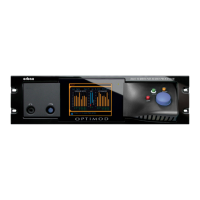1-16
INTRODUCTION ORBAN MODEL 8685
When the optional HD-SDI module is installed, the 8685 can provide up to 11 frames
of video delay. This is more than enough to maintain AV-sync when the optional
Dolby-E decoder, Dolby-E encoder, and Penteo® upmixer are installed in the audio
path. The delay of the 8685’s audio processing is usually set to exactly one frame.
Using OPTIMOD 8685 as a Studio Level Controller
See page 6-101 for a block diagram of the 8685’s signal processing and routing.
One or more of the 8685’s processors can be used as a studio AGC, digital ra-
dio/netcast processor, or low-delay talent headphone processor. The surround and
2.0 outputs can be configured independently to emit one of the following signals:
• Stereo enhancement, equalization, and AGC without look-ahead peak limiting
• Stereo enhancement, equalization, and AGC with peak limiting
• Stereo enhancement, equalization, and multiband processing (two-band or 5-
band, including AGC) without peak limiting
• Stereo enhancement, equalization, and multiband processing (two-band or 5-
band, including AGC) with peak limiting
About Transmission Levels and Metering
Meters
Studio engineers and transmission engineers consider audio levels and their meas-
urements differently, so they typically use different methods of metering to monitor
these levels. The VU meter is an average-responding meter (measuring the approxi-
mate RMS level) with a 300ms rise time and decay time; the VU indication usually
ABSOLUTE PEAK
PPM
VU
Figure 1-1: Absolute Peak Level, VU and PPM Reading

